Clean energy industries have a bright outlook and hydraulic cylinders have taken a center stage in the future of this sector. Hydraulic cylinders function as linear actuators and they receive power through hydrostatic energy. Clean energy sources such as wind power, solar power, and wave power provide exciting opportunities in energy technology.
Clean Energy

The evolution of these renewable energy sources will increase the role of hydraulic power, and hydraulic cylinders will be used for angling the blades of the wind turbines, positioning the mirrors for the best reflection of the sun’s rays, and converting wave activity into electricity.
Challenges of Clean Energy
Challenges faced by clean energy industries prevent the fast adoption of clean energy sources. The ‘fuel’ for clean energy sources is free, but the equipment needs to be sturdy. Capital costs are the most evident barrier to using clean energy sources. Siting and transmission are also key challenges where there is a need for an ideal location for solar farms and wind turbines, and a good infrastructure for moving the energy from generation end to the consumer end.
Hydraulics for Clean Energy
Hydraulic machines and hydraulic power are the leading supplies in the clean energy industry. The clean energy industry utilizing hydraulic power and running on hydraulics will need the following parts that form a hydraulic cylinder:
- Cylinder base
- Cylinder barrel
- Piston
- Cylinder head
- Piston rod
- Seals
- Threaded gland
- Gaskets
- Alignment Coupler
Maintenance
Maintaining hydraulic fluids and other equipment requires proper and ongoing maintenance for smooth functioning. Hydraulic systems accumulate a certain amount of contaminants in the form of burrs, rag fibers, moisture, weld splatter, solution, and sealant. A clean hydraulic fluid can keep the system cool and transmit the pressure well. Therefore, the sources of contamination should be eliminated or reduced and filters should be changed to ensure a steady provision of clean energy. The maintenance process should consider filtration, prevention, and additive replenishment.
Derzeit gibt es keine Ergebnisse.


